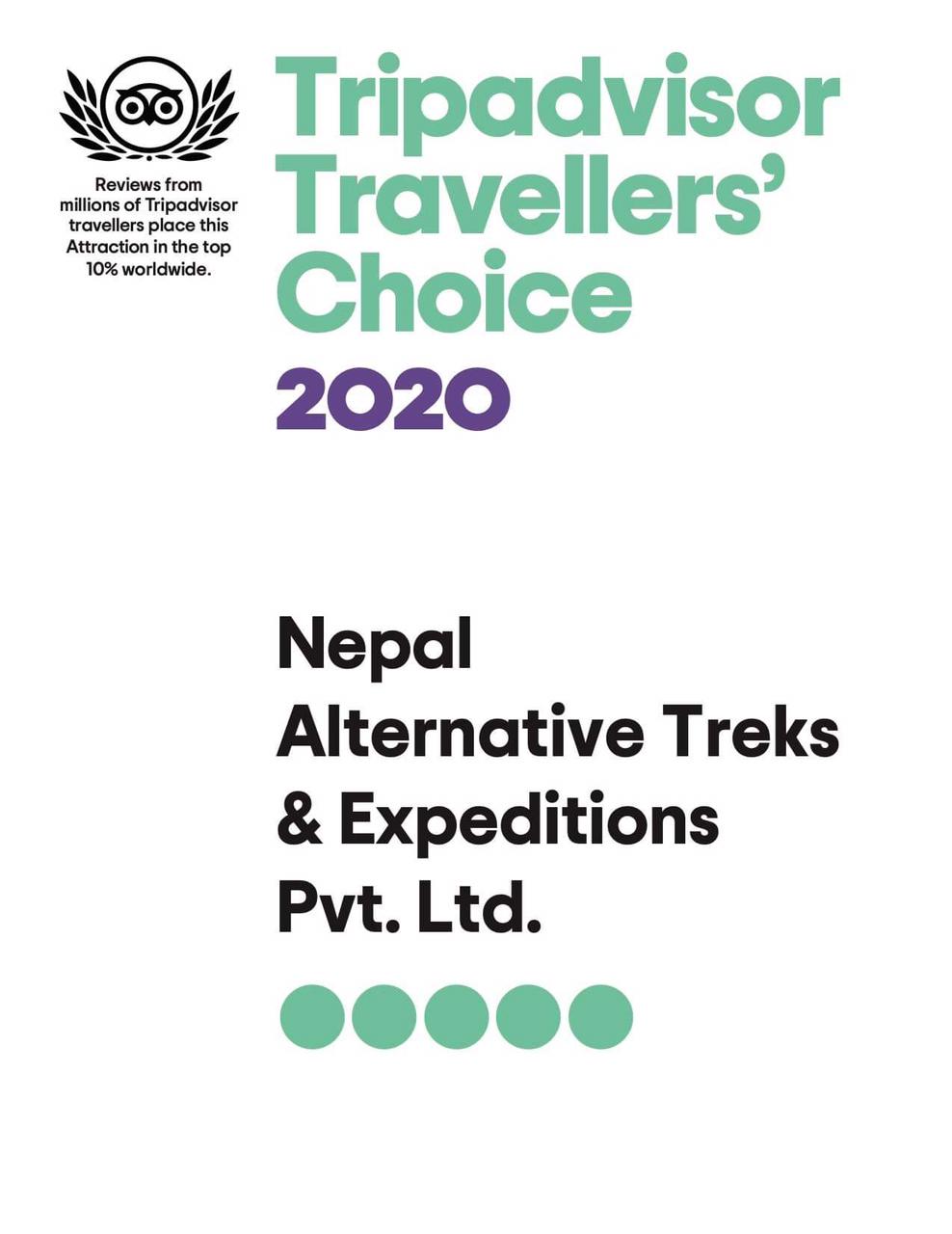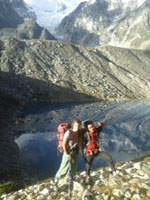1. Is previous hiking experience is required ?
As long as you are in good physical shape, you do not require any hiking experience for short treks. However, if you are planning a trek longer than a week, some physical fitness programs such as running and hiking is recommended before you embark on a trek.
2. What equipment should I bring ?
When selecting your personal items, keep in mind the number of days you'll be trekking tea house/ camping, the time of year and the altitude. We advise our clients to bring these items:
· Sleeping Bag
· Down Jacket
· Long sleeved shirt
· Jumper or fleecy jacket
· T - shirts
· Trekking shoes or boots
· Comfy shoes for around the camp ( for camping trek)
· wool socks
· Light cotton socks
· Rucksack ( 45 liter )
· Sun hat
· Woollen hat
· Gloves
· Sun block for lips
· Goggles or sunglasses
· Long underwear
· Insulated pants
· Nylon windbreaker
· Nylon wind pants
· Water bottle
· Sewing kit
· Medical & first aid kit
· Flash light
· Batteries and bulbs
· Swiss army knife
· Towel and toiletries
3. What is Teahouse Trekking? And how it is organized?
Teahouse trekking is guided walking and very popular in the well-developed tourist regions including Annapurna, Everest and Langtang – Helambu, where western cuisine as well as Nepalese food (Dalbhat) is available. Overnight accommodation is in good, clean guest houses, lodges and hotels.
4. What is Camping trek and it is organized?
A camping trek is fully organized and supported with a team of guides, cooks, sherpas and porters to accompany you. Our porters carry all the trekking gear, food, fuel and personal belongings. Our cooks prepare hot and delicious meals. Trekkers need only to carry a small bag as required for the day. At night, tents for dining, sleeping and ablutions tents are provided and set up also mattresses and down-filled sleeping bags, tables and seating.
In a typical camping trek, we start the day around 6 a.m. with a cup of hot tea/cofee. You are then provided with a bowl of warm water for washing. Then trekkers enjoy breakfast before leaving camp. The trek begins around 7.30 - 8 a.m.
Trekkers can set their pace for pausing and sightseeing and the walk to the lunch spot will normally take 3 hours. On arrival, you are served hot lunch. In the afternoon, after walking for another 3 to 4 hours, you arrive at the next camp around 5 p.m. Tea and snacks are served while our staff readies the camp. Dinner time is around 6/7 p.m. in the dining tent, lit with lanterns and comfortably furnished. The food is healthy, wholesome and hygienically prepared.
5. What is home stay trekking and how it is organized?
Home stay trekking means staying in local community lodge or local people house. We will provide you local food, interaction with them, look their life style from the closest view and experience their culture. Our porter will carry your luggage.
6. Is a Trekking permit required?
The government of Nepal no longer requires a special trekking permit for Everest, Annapurna, Langtang, and some other regions. However, conservation permit or National park permits are required for these regions. There are few restricted trekking areas in Nepal, where trekking permits are required as Dolpo, Mustang, Manaslu, kanchunjunga, Nar-fu, Tsum valley and Dhaulagiri round trekking.
7. What happens if I get sick?
The most important thing is DON’T PANIC. You should ALWAYS ensure that you have sufficient insurance in case you should have to be evacuated though Nepal alternative treks staff will have medical kid to treat you. A slight case of diarrhea is to be expected, as well as sprains and muscle aches – all a part of walking in the hills. Altitude sickness is extremely dangerous but mostly avoidable if you follow a few simple rules: trek high and sleep low, drink at least 2 litters of water per day (not including beer or any alchoholic drinks!), and BE SENSIBLE. If you feel shortness of breath, a slight headache or dizziness, tell your porter/guide and rest immediately. Lie down, drink water. If you are still feeling unwell you may consider going down a few hundred meters. Do not pretend you are okay, and do not go down alone. A descent of a few hundred meters overnight may be enough to make you fully able to start trekking again tomorrow.
8. What are your payment terms?
To know the term of payment please click here
9. How long have you been in business?
We have been serving in this field for over 12 years and are trustable and government registered trekking agency. Please visit here for more detail.
10. Does Nepal alternative treks accept credit cards or online payment ?
We accept Visa card and Master Card for payment through online payment system. If you are paying in person in Nepal, we request that you pay in cash as the bank charges for credit cards are quite high. click here for more detail
11. Do you have any referral customers?
To know about our former clients' referral, please click here
12. What is the maximum weight allowed on domestic flights?
The normal weight limit is 15 k.g. While the helicopter shuttle system is operating the limit to Lukla is 10 kg.
13. How many extra days should I allow in case of flight cancellation?
If you are flying from a remote mountain airstrip like Lukla, Jomsom, Simikot, Taplejung and Dolpo, you should keep at least two spare days before your departure for home.
14. Is it possible/easy to get equipment on hire?
There are trekking shops at Thamel, in kathmandu in particular, where you can easily rent or buy items like sleeping bags, down jackets, rucksacks and all required gears.
15. Is communication to home possible while on trek?
There are mobile network, Data internet and WIFI in most of the popular trekking routes from which you can make comunicate and international calls with your family and friends.
16. Are Nepal alternative Trekking Company's trekking crew insured?
Our company insures all our trekking staff, including porters.
17. What arrangements for drinking water are made while on trek?
You should bring a one-litter water bottle with you on the trek. We prefer that you purify water yourself using iodine in order to save scarce fuel. You also can buy mineral water and boilled/filtered water during trek though.
18. What if the guide/porter leaves me alone the trail?
Guide and porter will walk always together with you but sometimes porter may go on ahead to book room in a good place to stay overnight and in case if there is not phone/cummunication available to reserve lodge in advance. However, Nepal alternative Trekking Company's guide will never leave you behind. It is guaranteed.
19. How much is the weight limits that porters carry?
Weight limits for porters to carry is 22 k.g. .
20. What is the best season for trekking in Nepal? And can I go trekking in the months of June and July?
The best time for trekking in Nepal is September, October, November and March/April/May. It is not idead for trekking during the monsoon season from June to August except treks in the Himalayan rain shadow like Upper Mustang, Dolpo and Kailash.
21. What is the weather & temperature like?
Weather in the mountains is notoriously difficult to predict. Of course, at night it is generally cold, and in winter the days can be quite beautiful if the sun is out. Trekking in spring (March – April- May ) is particularly lovely as the rhododendrons are in full bloom, and the mountains still have plenty of high snow to enhance your photos. You need to be aware that it can get pretty hot and sunstroke can be a risk. Good polarizing sunglasses or glacier glasses (not trendy fashion ones) for high altitudes/winter treks, and a large brimmed hat are a necessity. It is also important to make sure that you can stay warm and dry in just about any conditions. Expect the unexpected!
Between 1000m and 3500m the temperature could be as high as 20 degree c. to 5 degree c. low. At higher altitude, the temperature ranges from 20 degree c. to -10 degree c.. During winter it is around 10 degree c. colder.
22. What is the role of your guide while we are on the trekking?
Our guide is extensively trained (Government registered) and experienced on safe operations and handling Tea House (Lodge to Lodge), Camping (Tent to Tent) trekking and home stay trekking. His primary concern is safety and your enjoyment of the trip. Our guide is knowledgeable about the Himalayas, altitude sickness, geography, Nepali culture and customs as well as flora and fauna of this area.
23. Can we ask questions to your guide as much as we want?
Please, do not hesitate to ask your guide questions. All of the guides have a wealth of information and are happy to explain on any topic in which you may be interested. They have been trained to provide information while they are on the trekking.
24. Is there an opportunity for me to give feedback regarding my trip or overnight hotel as well as food and crews?
At the conclusion of your trekking/expedition trip, we will be more than happy to share time with you in our head office and sit down for chatting about your trip. We do have comment books or write feedback through email you as your opinion of our service is valuable to us. We always expect your support to share your experience in our facebook page, trip advisor and other social networks.
25. Should I drink more water than usual?
It deepens how high you do trekking however trekking in Nepal is obviously bit in higher places compared to other countries, which will be minimum altitude from 1500 mtr. to 5545 Meter. above the sea level. At these altitudes your body can become dehydrated more quickly, and it is important that you drink water regularly (4 - 5 liters a day).
26. Is it customary to give gratuities to my guide and porter for my trip?
Many of our guests have asked us about the customary practice of recognizing exceptional service through tipping while we consider it your personal decision. To be frank and honest with you, tipping is a culture at the end of the trip and standerd is 10% to guide and 8% to porter of your total trip payment to office but more or less is your personal decision which more depends on thier service and hospitality.
27. Will somebody come to pick me up at the Airport upon my arrival?
Yes, our Airport Representative will come to the airport to pick you up and greet you with flowers. Outside of Terminal Hall, he/she will be displaying a play card of Nepal Alternative Treks & Expedition with your name on it. Upon arrival, you will be transferred to hotel or our office.








 Quick Inquiry
Quick Inquiry


















